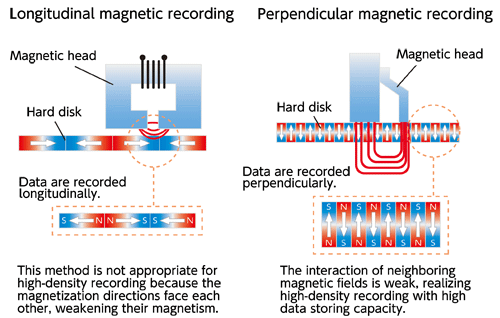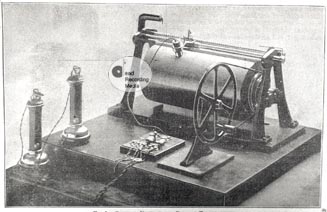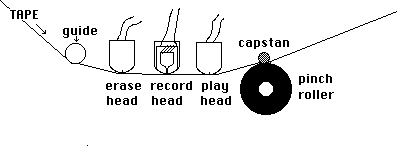Memory Storage Devices: Difference between revisions
Donghyun727 (talk | contribs) |
Donghyun727 (talk | contribs) |
||
| Line 24: | Line 24: | ||
The videotape recorder was the next greatest innovation in the recording industry, as it was the first machine which allowed recording of video onto a tape. However, it didn't become popular until the cassette format was introduced by Sony in the 1970s, which revolutionized the videotape industry. Improvements along the line led to the development of Walkman, which was one of the greatest successes for a portable videotape recorder, distributed all over the world. According to Sony, 100 million units were sold in the U.S alone during the 20 years of Walkman devices. Walkman was the first product which was able to effectively tackle the issue of inconsistency in quality, and was extremely convenient in its portability. | The videotape recorder was the next greatest innovation in the recording industry, as it was the first machine which allowed recording of video onto a tape. However, it didn't become popular until the cassette format was introduced by Sony in the 1970s, which revolutionized the videotape industry. Improvements along the line led to the development of Walkman, which was one of the greatest successes for a portable videotape recorder, distributed all over the world. According to Sony, 100 million units were sold in the U.S alone during the 20 years of Walkman devices. Walkman was the first product which was able to effectively tackle the issue of inconsistency in quality, and was extremely convenient in its portability. | ||
[[File:walkman.jpg]] | |||
Revision as of 20:38, 5 December 2015
--Lee Dong Hyun dlee682 (talk) 19:06, 5 December 2015 (EST)
Magnetic storage devices use the method of magnetic recording to preserve data.
Magnetic recording
Magnetic recording is a process where portions of a magnetic material are selectively magnetized with the use of electrical signals.
History of recording devices
As technology improved significantly over time, a wide number of recording devices have been introduced.
Telegraphone
The first use of this kind of technique was introduced by a Danish engineer Valdemar Poulsen in 1900. He created a machine called telegraphone that allowed him to record speech magnetically on a steel wire, and this became the start of many storage devices that are existent today. After the introduction, he continued to develop the technology and improved the sound quality through the use of direct current onto the recording head. However, the signals were weak and difficult to amplify, with the quality of the product highly fluctuating and thus unreliable.
Magnetophone
The Magnetophone was developed in Germany in the 1930s, when other kinds of magnetic recorders were being developed in countries such as Britain, USA, and Japan. It started from Ludwig Blattner, who bought the rights of the steel tape device and modified it into the Blattnerphone. The magnetophone an improved version of the existing telegraphone in that it was portable and it contained its own amplifier and speaker. Also, it no longer used the highly unreliable steel wire and used reels of acetate tape and magnetite coating. Further improvements down the line replaced the use of DC currents to AC currents, which allowed production of a 60 dB dynamic range of sound.
VTR (Videotape recorder)
The videotape recorder was the next greatest innovation in the recording industry, as it was the first machine which allowed recording of video onto a tape. However, it didn't become popular until the cassette format was introduced by Sony in the 1970s, which revolutionized the videotape industry. Improvements along the line led to the development of Walkman, which was one of the greatest successes for a portable videotape recorder, distributed all over the world. According to Sony, 100 million units were sold in the U.S alone during the 20 years of Walkman devices. Walkman was the first product which was able to effectively tackle the issue of inconsistency in quality, and was extremely convenient in its portability.
The cassette format became the basis of the videotape revolution in the 1970's. Sony introduced the 3/4-inch U-matic VCR in the U.S. in 1971, and for the first time, allowed other manufacturers to sell machines that could play the cassette, and thus succeeded in establishing a world standard for the 3/4-inch videocassette. In 1975 Sony introduced in the U.S. the Betamax consumer VCR console for $2295 with one-hour 1/2-inch tape cassettes for $15.95. Sony sought to create a standardized format, as it had done with the U-matic, by getting other companies to produce machines that would play the Beta cassettes, but refused to license the cassettes themselves. The next year JVC introduced the VHS format and a VCR for only $885 and licensed the technology to other companies. Sony would lose the "Betamax War" with VHS, but it would triumph with the Walkman portable audio cassette player in 1979. The TPS-L2 inaugurated a new era of personal music listening. The Sony family of portable personal music players would grow to include over 500 models, from the original pocket-sized 14-oz Walkman to the D-88 Pocket DiscMan of 1988 to the DAT Walkman TCD-D3 of 1991 to the MiniDisc of 1992 to the digital Discman of 1999. According to Sony, in the 20-year history of the Walkman devices, 100 million units were sold in the U.S. creating a $1 billion industry. (19)
The transformation of the credit card created a multibillion-dollar industry. IBM had perfected in the 1960s a method of adhering a magnetic stripe to the surface of a plastic credit card. This stripe could have multiple tracks and allow read and write operations from special machines capable of decoding binary data. American Airlines and American Express first used striped cards for ticketing at O'Hare Airport in Chicago. The first of three tracks on early credit cards was used by the airline industry. The second track contained identifying information such as account numbers and names. The third track was read-write and could hold the balance of an account. The American Banking Association approved use of the magnetic stripe in 1971 but most banks resisted its use. In 1972, Dee W. Hock, president of National BankAmericard Inc. (NBI, later to be called Visa), adopted the magnetic stripe for its new Uni-Card division in competition with the cards of the nation's largest banks, including Bank of America and Citibank. Eventually, the banks followed his lead and made the magnetic stripe common on all credit cards. (20)
One of the most significant developments of the 1970s was the floppy disk. The engineers at IBM who had developed RAMAC and the early disk drives understood their significance. In late 1967, a group known as "Dirty Dozen" left the IBM research lab in San Jose to found Information Storage Systems (ISS) that sold disk drives through Telex. They were followed during next three years by over 200 other engineers who would leave IBM for the new disk drive companies like Memorex and Shugart Associates. After the departure of the Dirty Dozen, IBM assigned David I. Noble the job of designing a cheap and simple device to load operating code into large computers. Called the Initial Control Program Load, it was supposed to cost only $5 and have a capacity of 256 KB. During 1968 Noble experimented with tape cartridges, RCA 45-rpm records, dictating belts, a magnetic disk with grooves developed by Telefunken, but finally created his own solution -- the floppy disk. Called the "Minnow," it was a plastic disk 8 inches in diameter, 1.5 mm thick, coated on one side with iron oxide, attached to a foam pad and designed to rotate on a turntable driven by an idler wheel. A read-only magnetic head was moved over the disk by solenoids and read data from tracks prerecorded on the disk at a density of 1100 bits per inch. The disk was "hard-sectored" with 8 holes around the center to mark the beginning of data sectors. At first, its capacity was only 81.6 KB, but by Feb. 1969 he had doubled the thickness of the plastic base to 3 mm and coated both sides to add more capacity. In June 1969, the Minnow was added to the IBM System 370 and soon began to be used by other divisions in IBM. In 1970, the name was changed to Igar and Noble had a staff of 25 engineers to help him make improvements. By 1971, Igar became the 33FD disk drive and the 8-inch floppy disk became the Type 1 diskette. The speed was 360 rpm, with head access time of 50 milliseconds. The 8 hard sector holes were replaced by a single index hole for "soft sectors" or "IBM sectoring" across 77 tracks. In 1976 the 43FD disk drive was sold with dual heads to read and write to both sides of the diskette. A new model 53FD was added in 1976 that used modified frequency modulation to record double-density on both sides, resulting in a capacity of 1200 KB. (21)
The floppy disk emerged from IBM at the same time the microprocessor emerged from Intel. When the first Altair and Imsai microcomputers came on the market in 1974 using the 8080 processor, there were no peripherals available to store data or even display words on a CRT screen. The only input/output device was a Teletype. There wasn't even an operating system for these new computers. In 1975, Alan Shugart produced an 8-inch floppy disk to hold 800k that offered for the first time a low-cost drive for the emerging personal computer market. In 1976, Jim Adkisson, a Shugart engineer, sat down for lunch with a customer who complained that the 8-inch drive was too big for the personal computer. When Adkisson asked what the size should be, the customer pointed to a napkin on the table and said, "About that size." Adkisson returned to the Shugart lab with the napkin and designed the 5.25-inch floppy drive, introduced in 1976 as the model SA400 with a capacity of 110 KB. The model became one of Shugart's best sellers, with shipments the rose to 4000 drives per day. The company turned to Matsushita in Japan to help make the drives, starting that company on its rise to becoming the largest floppy drive manufacturer in the world. Sony developed a 3.5-inch floppy drive by 1980 and began a two-year effort to make it the U.S. floppy disk standard. Sony declared that its new drive was smaller, faster, better protected, and could fit in a shirt pocket. A group of U. S. disk manufacturers opposed the new standard. The group was led by Shugart Associates and Control Data, and included Verbatim, Micro Peripherals, Dysan and Tabor. They sought to keep the standard 8-inch and 5.25-inch disks made by U.S. companies since IBM introduced the floppy disk in 1971. However, no American company had a product equal to the Japanese diskette. Sales of the 3.5-inch floppy began to surpass the 5.25-inch version by 1989, and Japanese companies would drive most U.S. disk producers out of the market. (22)
The Digital revolution of the 1980s continued the use of the cassette and disk and magnetic tape. In1986 Sony/Philips introduced Digital Audio Tape, or DAT, as a result of efforts of the 81-member firm R-DAT consortium to develop a recordable version of the optical compact disc. Because of copyright problems, electronics firms delayed development of consumer products and DAT remained a high-priced professional medium. In 1991 the Alesis Corporation of Los Angeles introduced its new ADAT machine that recorded 8 tracks of digital audio to a standard S-VHS videocassette using the same helical scan technology that created the videocassette boom in the 1970s. With a list price of $3995, and cassettes at $15, the ADAT made multitrack digital recording affordable for the small studio, with the ability to connect together up to 16 ADATs for a total of 128 synchronized tracks. 20,000 were sold in its first year from October 1992 to November 1993 and 80,000 sold by 1998. The Electronic Musician declared in Oct. 1992 that "ADAT is more than a technological innovation; it's a social force." In 1992 Sony began sales of the MiniDisc that had been announced May 30, 1991. The MD was a recordable magneto-optical disc encased in a plastic cartridge with the same 74-minute capacity as the CD but at half the size and with greater compression. The MD was intended to replace the CD and the compact cassette. Sales of cassette tapes began to decline in1989, and Sony felt that the compact cassette system was nearing the end. In1993 the Tascam division of Teac introduced in February the DA-88 digital 8-track recorder for $4,499, the first modular digital multitrack (MDM) recorder to use the Hi-8 videotape. In1997 sales began of the Digital Video cassettes following the DV and miniDV standard introduced by Panasonic & Sony. In 1999 Panasonic announced Digital-VHS (DVHS), the first VCR capable of recording all 18 Digital TV format including HDTV. Just as computers continued to use magnetic hard disks to store data, audio recording continued to use magnetic tape and cassettes for the new era of digital sound. (23)
How it works
The main physics behind magnetic recording involves specific patterns of magnetization on a track which corresponds to specific signals to be stored. The signals triggers the magnetization of the material as it passes through the recording device, and the remnants of the magnetization are the codes which become the basis of the storage of the data. To retrieve the data stored, the reverse process happens: the magnetization is detected by the reader which reproduces the signal that initially triggered the magnetization. The two earliest versions of this recording were longitudinal recording and perpendicular recording.

Recording methods
Analog Recording
Analog recording was the most popular method used when tapes were the most prevalent recording devices. The tape would run at a constant speed, and the writing head magnetizes the tape in response to the signals required to record a particular piece of data. Once a magnetization distribution is completed to store the relevant data, this distribution can be read out to replay the original signal which triggered the magnetization. The commonly used magnetic particles for this method are Iron oxide particles or Chromium oxide.
Digital Recording
Digital recording can be considered a more advanced method of recording, as instead of creating a magnetization distribution, digital recording makes use of magnetic states. The method involves the usage of two stable magnetic states, which are the +Ms and the -Ms on a hysteresis loop. This converts into a binary code of 0 and 1 to construct a data of existence/non-existence of signal in the particular area of recording medium. This is a technique which is used to create devices such as floppy disks and the currently popular hard disk drives.
References
"Magnetic Recording | Electronics." Encyclopedia Britannica Online. Encyclopedia Britannica. Web. 6 Dec. 2015. <http://www.britannica.com/topic/magnetic-recording>.
"COEN 180." COEN 180. Web. 6 Dec. 2015. <http://www.cse.scu.edu/~tschwarz/coen180_04/LN/physics.html>.
"ANALOG RECORDING OF SOUND." Analog Recording. Web. 6 Dec. 2015. <http://artsites.ucsc.edu/EMS/music/tech_background/te-19/teces_19.html>.
"Basics of Digital Recording." Digital Recording. Web. 6 Dec. 2015. <http://artsites.ucsc.edu/EMS/music/tech_background/TE-16/teces_16.html>.
"SPring-8, the Large Synchrotron Radiation Facility." Novel Magnetic Material Discovered in Meteorite — SPring-8 Web Site. Web. 6 Dec. 2015. <http://www.spring8.or.jp/en/news_publications/research_highlights/no_51/>.
"The History of Magnetic Recording." The History of Magnetic Recording. Web. 6 Dec. 2015. <http://www.aes.org/aeshc/docs/recording.technology.history/magnetic4.html>.
"Inventing the Wire Recorder." History of the Wire Recorder. Web. 6 Dec. 2015. <http://www.recording-history.org/HTML/wire2.php>.
"RIP Walkman: Goodbye after 30 Years." The Guardian. Web. 6 Dec. 2015. <http://www.theguardian.com/music/musicblog/2010/oct/25/rip-walkman-30-years>.



